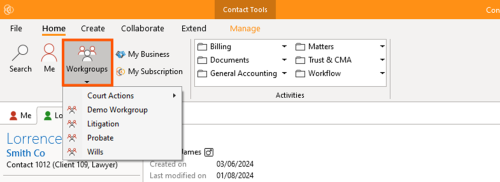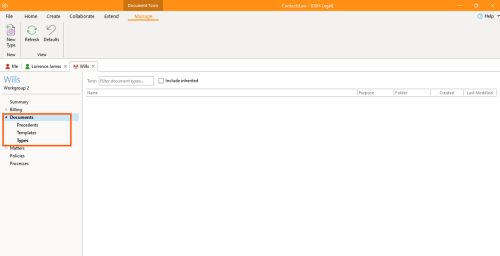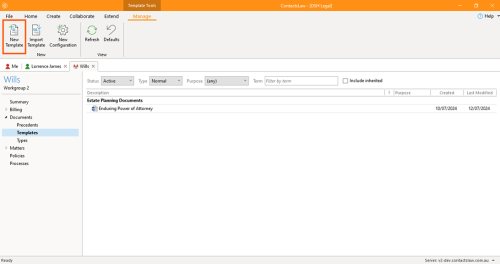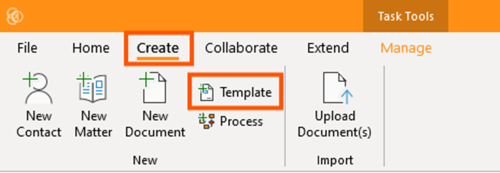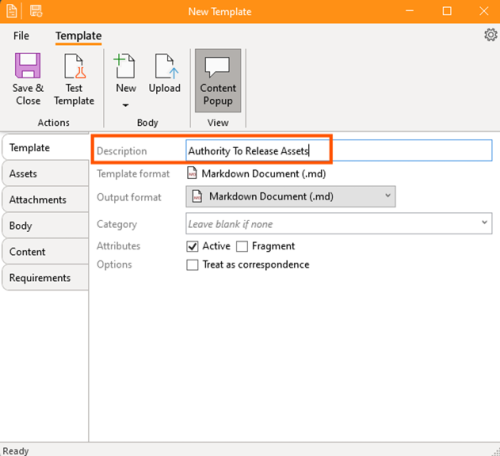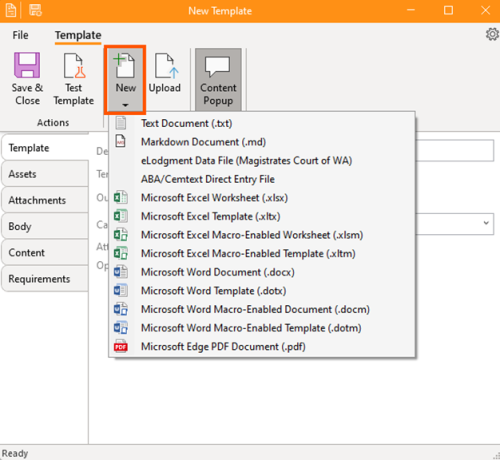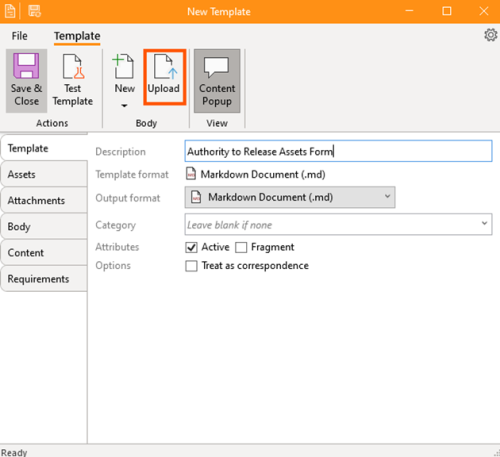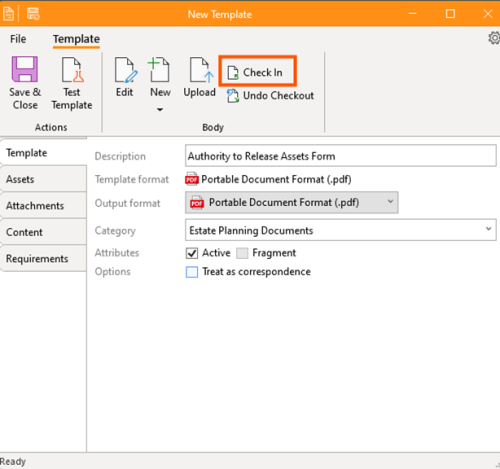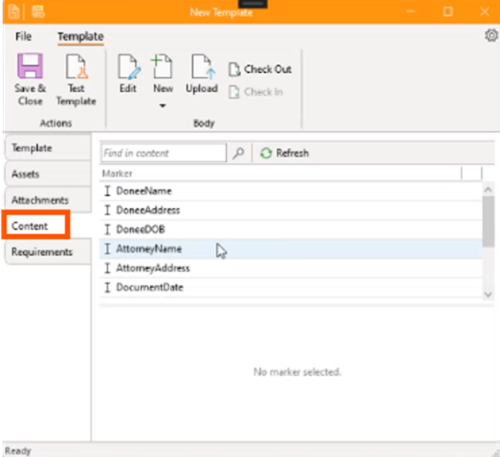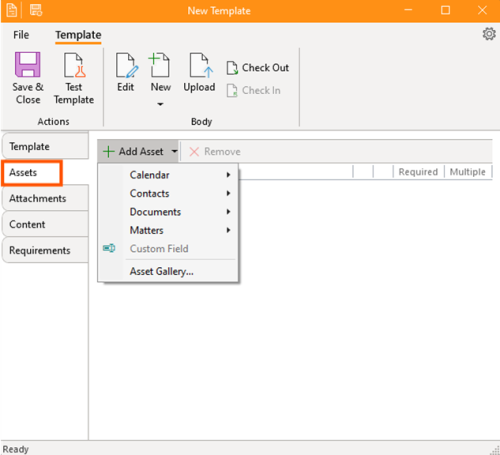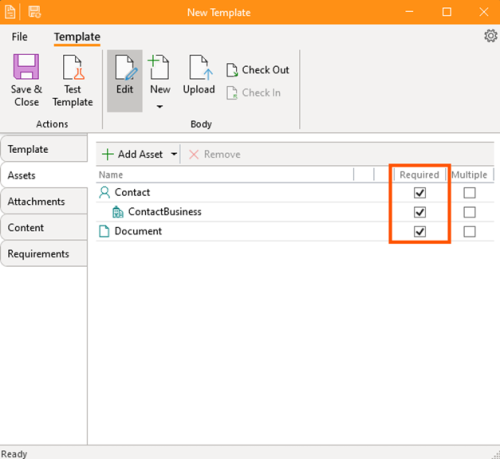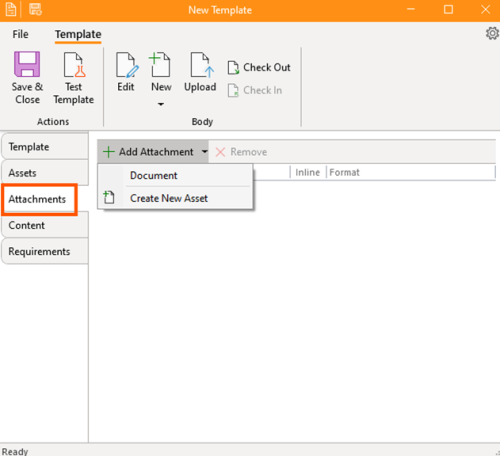How-To:Document Template: Difference between revisions
No edit summary |
No edit summary |
||
| Line 6: | Line 6: | ||
# Both options open the “'''New Template'''” window. The "Description" field is the name of the template. [[File:Create Template - Description.png|none|thumb|500x500px]] | # Both options open the “'''New Template'''” window. The "Description" field is the name of the template. [[File:Create Template - Description.png|none|thumb|500x500px]] | ||
# There are two ways to build a new template: either selecting "New" and selecting a file type to create a completely new template. Alternatively, you can use the "Upload" button to upload a document from your computer and use that as a basis for your template. [[File:Step 4.1- Create Template.png|none|thumb|500x500px|[[File:Step 4.2- Create Template.png|none|thumb|500x500px]]]] | # There are two ways to build a new template: either selecting "New" and selecting a file type to create a completely new template. Alternatively, you can use the "Upload" button to upload a document from your computer and use that as a basis for your template. [[File:Step 4.1- Create Template.png|none|thumb|500x500px|[[File:Step 4.2- Create Template.png|none|thumb|500x500px]]]] | ||
# Select your desired options: '''Category:''' this option is for the purpose of grouping similar templates together (e.g. "Correspondence" or "Banking Documents"). '''Attributes - Active:''' selecting this will make the template appear on the list of templates. Unselect this to hide the template from the active template list. '''Attributes - Fragment:''' Fragments are essentially templates that can be included inside other templates, for example, letter headers and signature blocks. '''Options:''' Designating the template as correspondence will allow the software to treat the template as such with additional functionlity. [[File:Step 7 - Create Template.png|none|thumb|500x500px]] | # Select your desired options: '''Category:''' this option is for the purpose of grouping similar templates together (e.g. "Correspondence" or "Banking Documents"). '''Attributes - Active:''' selecting this will make the template appear on the list of templates. Unselect this to hide the template from the active template list. '''Attributes - Fragment:''' Fragments are essentially templates that can be included inside other templates, for example, letter headers and signature blocks. '''Options:''' Designating the template as correspondence will allow the software to treat the template as such with additional functionlity. [[File:Step 7 - Create Template.png|none|thumb|500x500px]] | ||
# Ordinarily the next step is to edit the body of your template. Do this by clicking "Edit". This will open the document in the native editing application e.g. Microsoft Word (.docx) and Adobe Acrobat (.pdf). [[File:Step 8 - Create Template.png|none|thumb|500x500px]] | # Ordinarily the next step is to edit the body of your template. Do this by clicking "Edit". This will open the document in the native editing application e.g. Microsoft Word (.docx) and Adobe Acrobat (.pdf). [[File:Step 8 - Create Template.png|none|thumb|500x500px]] | ||
#When editing the document, you need to identify where you want data from ContactsLaw to be drawn upon. These areas are then identified using '''"Content Markers"'''. '''<u>Microsoft Word (.docx) and most other formats</u>''' In Microsoft Word, a content marker is created using curley brackets (that is: '''{''' and '''}''' ) with a custom identifying name inbetween. If you reuse the same identifying name, the system will treat this as one content marker. For example: {'''ClientFirstName}''' and '''{ClientDOB}''' would be good examples of simple content markers. Note that the name inbetween the brackets does not itself draw on the data in ContactsLaw - it is merely an identifier for your reference. The connection to the data is made at a later stage. '''<u>Adobe Acrobat (.pdf)</u>''' A content marker in PDF documents is created slightly differently. The software treats form fields created by Adobe Acrobat as a content marker. This is usually desirable as existing editable PDF documents can be used as the basis for a template in the first instance, or otherwise, form fields can often be reliably generated in Adobe Acrobat automatically using that software. | #When editing the document, you need to identify where you want data from ContactsLaw to be drawn upon. These areas are then identified using '''"Content Markers"'''. '''<u>Microsoft Word (.docx) and most other formats</u>''' In Microsoft Word, a content marker is created using curley brackets (that is: '''{''' and '''}''' ) with a custom identifying name inbetween. If you reuse the same identifying name, the system will treat this as one content marker. For example: {'''ClientFirstName}''' and '''{ClientDOB}''' would be good examples of simple content markers. Note that the name inbetween the brackets does not itself draw on the data in ContactsLaw - it is merely an identifier for your reference. The connection to the data is made at a later stage. '''<u>Adobe Acrobat (.pdf)</u>''' A content marker in PDF documents is created slightly differently. The software treats form fields created by Adobe Acrobat as a content marker. This is usually desirable as existing editable PDF documents can be used as the basis for a template in the first instance, or otherwise, form fields can often be reliably generated in Adobe Acrobat automatically using that software. | ||
Revision as of 20:27, 20 August 2024
ContactsLaw provides a comprehensive document creation system. It's templating functions allow the creation and sharing of powerful templates to reduce data entry and to simplfy document creation. Users can build and configure their own templates within the system. The below guide will explain the key steps in creating a template.
- To open the template creation window, start by selecting the relevant workgroup.
- The template creation window can then be opened, either by:
- Option 1: Select “Documents” on the vertical menu and choose “Templates”. Then click, “New Template”.
- Option 2: navigate to the “Create” section in the upper part of your screen and click “Template”.
- Both options open the “New Template” window. The "Description" field is the name of the template.
- There are two ways to build a new template: either selecting "New" and selecting a file type to create a completely new template. Alternatively, you can use the "Upload" button to upload a document from your computer and use that as a basis for your template.
- Select your desired options: Category: this option is for the purpose of grouping similar templates together (e.g. "Correspondence" or "Banking Documents"). Attributes - Active: selecting this will make the template appear on the list of templates. Unselect this to hide the template from the active template list. Attributes - Fragment: Fragments are essentially templates that can be included inside other templates, for example, letter headers and signature blocks. Options: Designating the template as correspondence will allow the software to treat the template as such with additional functionlity.
- Ordinarily the next step is to edit the body of your template. Do this by clicking "Edit". This will open the document in the native editing application e.g. Microsoft Word (.docx) and Adobe Acrobat (.pdf).
- When editing the document, you need to identify where you want data from ContactsLaw to be drawn upon. These areas are then identified using "Content Markers". Microsoft Word (.docx) and most other formats In Microsoft Word, a content marker is created using curley brackets (that is: { and } ) with a custom identifying name inbetween. If you reuse the same identifying name, the system will treat this as one content marker. For example: {ClientFirstName} and {ClientDOB} would be good examples of simple content markers. Note that the name inbetween the brackets does not itself draw on the data in ContactsLaw - it is merely an identifier for your reference. The connection to the data is made at a later stage. Adobe Acrobat (.pdf) A content marker in PDF documents is created slightly differently. The software treats form fields created by Adobe Acrobat as a content marker. This is usually desirable as existing editable PDF documents can be used as the basis for a template in the first instance, or otherwise, form fields can often be reliably generated in Adobe Acrobat automatically using that software.
- Once you have finished editing the document, save and close the native editor (Microsoft Word/Acrobat etc). Click “Check In” on the ContactsLaw template editor.
- Next go to the “Content” section where you see all those different fields of content markers, they're all in here and they appear in the order in which they were added to the document.
- For the “Asset” section, you will have the option to add what you want for the file or document to work.
- After adding assets, do not forget to check the box as “Required”.
- Then, go to the “Attachments” section and add a document or create a new asset.
- Double check the details and if it is all good just click “Save and Close”


